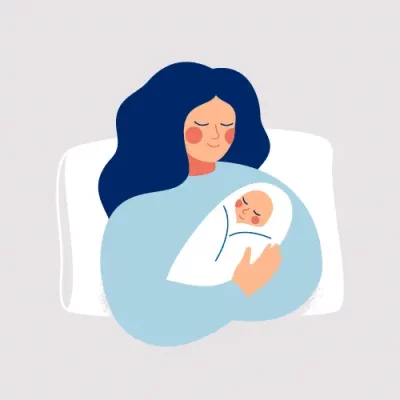Having a baby is one of the most exciting and life-changing events you will ever experience. But for many new mothers, it can also be a time of intense emotions – good and bad.
The first couple of weeks after giving birth are often referred to as the “baby blues,” and it’s completely normal for new mothers to feel overwhelmed and a bit down during this time. But when those feelings are prolonged and intensified beyond a couple of weeks postpartum, you may suffer from postpartum depression.
Recognizing the signs and differences between these two conditions is vital in knowing when to seek support.
In this blog post, we’ll discuss what baby blues and postpartum depression are, how they differ from each other, and how to recognize the signs of each. We’ll also talk about the impact of birth on new mothers and families and the importance of breaking the stigma and finding support to help you through this difficult and stressful time.
Understanding Baby Blues
Baby blues is a very common yet temporary emotional state many new mothers experience after giving birth. About 80% of women experience baby blues; the symptoms usually last a few days to a few weeks after delivery.
It’s typically triggered by the sudden decrease in hormones (estrogen and progesterone) that come with childbirth, as well as the physical discomfort and exhaustion of delivery.
Common triggers of baby blues include:
- Sudden decrease in hormones (estrogen and progesterone)
- Physical discomfort and exhaustion of delivery
- New routine or lifestyle due to baby
- Feeling isolated
- Financial stressors
- Lack of support from family or friends
Common symptoms of baby blues include:
- Feeling overwhelmed
- Unexplained crying or weepiness
- Mood swings
- Feeling anxious, irritable, or sad
- Lack of concentration and forgetfulness
- Difficulty sleeping, even when the baby is sleeping
Fortunately, there are ways to cope with baby blues. Here are some ways to help you manage your emotions throughout the baby blues stage:
1. Take time for yourself:
Make sure to carve out some “me time” in your day. Find activities you enjoy and allow yourself to indulge in them, whether it’s a hot shower, walking outdoors, or simply relaxing with a book.
2. Connect with others:
Stay connected with friends and family, even just talking over the phone or making plans for virtual hangouts. Connecting with others is crucial to avoid feelings of isolation. Having conversations with other adults beyond the full day of diaper changes and feedings can help you know you aren’t alone and allow you to reengage with others as an individual, not just your new role as a mother.
3. Practice self-care:
Eating a balanced diet, exercising, and getting enough sleep can help you strengthen your emotional wellness. Even taking a 10-minute nap or brushing your teeth can feel like self-care when the demands of a newborn are upon you. Do whatever you can to put yourself first, even for a small part of your day.
4. Get outside:
Spend time in nature or even step outside for a few minutes daily. This will help reduce stress and give you some much-needed moments of peace. Fresh air, sunshine, and looking at things far away are all proven to reduce stress, so see if you can sneak in some outdoor time alone or with a baby.
5. Limit screen time:
Too much time on your phone or laptop can increase stress and anxiety, so try to limit your use of electronic devices. We all know that increased amounts of blue light affect our REM and overall sleep quality, but it also affects you while you’re awake.
6. Ask for help:
Be bold and ask your partner, friends, or family to give you some space to get some self-care in, to assist in household tasks, for meal assistance, or to come over and spend time with you. Asking for help is expected, so there is no need to feel guilt or shame over needing others around you during this significant transition. Allowing others to love you during this time can feel like the weight on your shoulders is lifted.
Also, consider attending a postpartum support group or speaking with a therapist specializing in women’s mental health. These resources can give you more individualized support during these crucial first two weeks of postpartum care.
Remember, the baby blues don’t last forever! In receiving help, staying connected, and caring for yourself as best as possible, you can reduce the effects of baby blues and feel more like yourself as your body adjusts to postpartum life.
Recognizing Postpartum Depression
Postpartum depression (PPD) is a severe condition that affects about 1 in 7 postpartum women. This condition is significantly more intense and longer-lasting than baby blues, lasting for weeks or months after delivery.
Common symptoms of postpartum depression include:
- Intense sadness and hopelessness
- Loss of interest in once enjoyable activities
- Fatigue and exhaustion
- Anxiety or panic attacks
- Intense irritability and anger
- Difficulty concentrating or remembering things
- Changes in appetite, either eating more or less than usual
- Feeling disconnected from your baby
- Thoughts of harming yourself or your baby
It’s important to differentiate between PPD and baby blues. While both can include feeling overwhelmed, PPD has a much more severe impact on the mother’s mental health and well-being.
Differentiating between Baby Blues and Postpartum Depression:
Although some symptoms overlap, baby blues and postpartum depression have distinct differences. Here are some examples:
The Baby Blues Postpartum Depression
• Temporary, normally 2 weeks • Can last weeks or months
• Mild symptoms • More severe/intense symptoms.
• Feel weepy and short-tempered • Feel exhaustion and indecisive
• No suicide ideation • Thoughts of harming self or baby
Postpartum depression is highly treatable. If you think you might be experiencing PPD, talk to your doctor right away. You may feel a lot of guilt about your postpartum symptoms, but you are not alone in this experience, and seeking the help of others will make a significant impact on your recovery.
Risk Factors and Contributing Factors:
The exact cause of postpartum depression is unknown, but there are several risk factors and contributing factors that may increase the likelihood of developing PPD.
Risk factors for PPD include:
- History of depression or anxiety
- Lack of social support from family or friends
- Unplanned pregnancy
- Difficult birth experience
- Financial stressors or changes in employment
- Hormonal shifts after childbirth
Treatment Options:
The most common treatments for PPD are counseling, medication, and lifestyle changes. Your doctor can help you find the right combination of these treatments to address your symptoms. Counseling is essential to help you work through the underlying causes of your depression and build the coping skills needed to manage your symptoms.
Medication may also be recommended if counseling alone is not enough. But it’s essential to understand the risks associated with taking antidepressants while breastfeeding, so discuss all options thoroughly with your doctor before starting any medication.
Postpartum Psychosis
There is a rare form of PPD called postpartum psychosis that affects about 0.1% of all mothers and increases to 30% in those who also have bipolar disorder. Postpartum psychosis is the most severe form of PPD and requires immediate medical attention.
Symptoms of Postpartum Psychosis:
- Delusions, hallucinations, and paranoia
- Rapid changes in mood
- Extremely disorganized behavior
- Disordered thoughts
- Inappropriate behavior and language
- Going in and out of consciousness
- Loss of contact with reality/difficulty understanding what is real and not real
- Suicidal and/or homicidal thoughts
It is possible to experience this without a history of a mood disorder, so don’t ignore these symptoms if you are experiencing them. The primary treatment for this version of PPD is a combination of medication and monitoring your breastmilk to make sure it is safe for your baby with your medications.
Breaking the Stigma and Seeking Support
Postpartum depression and baby blues are prevalent conditions, but there is still an overall lack of awareness and stigma surrounding them. The stigma and misinformation about these conditions can make it difficult for sufferers to access support, leading to feelings of shame and guilt for experiencing common postpartum issues.
It’s essential to break the stigma surrounding PPD and baby blues so those affected will feel comfortable getting the help they need. Open communication between mothers, family members, and healthcare providers is essential in promoting awareness and understanding of these conditions.
Fortunately, numerous organizations and resources are available for those going through PPD or baby blues. Postpartum Progress, Moms Mental Health Initiative, and Postpartum Support International are just a few organizations offering help and support to those struggling with postpartum depression.
These organizations provide education, support groups, helplines, and other resources for women suffering from PPD or baby blues. There are also countless Facebook Groups and other social groups that encourage women sharing experiencing and finding support with each other during these early stages of parenthood.
By fostering open communication about PPD and baby blues and providing accessible resources for those affected, we can create a culture of understanding and empathy that will help reduce the stigma surrounding these conditions.
Conclusion
Postpartum depression and baby blues are incredibly common yet misunderstood conditions. It’s essential to understand the difference between PPD and baby blues, as PPD is a much more severe condition that requires more in-depth treatment. It’s also important to recognize the risk factors and contributing factors of PPD to reduce the likelihood of developing it.
By raising awareness about postpartum depression and baby blues, we can help reduce the stigma surrounding these conditions and ensure those affected can access the support they need.
The good news is that PPD is highly treatable with counseling, medication, and lifestyle changes. Numerous organizations are also available to support those suffering from PPD or baby blues.
If you or someone you know is experiencing symptoms of postpartum depression, don’t hesitate to call us or start here to find a counselor. Seeking help and support is essential in managing PPD and promoting mental health during the postpartum period, so don’t hesitate to get the help you need.
Remember that you’re not alone! If you have experienced baby blues or postpartum depression, share your tips in the comment section!








